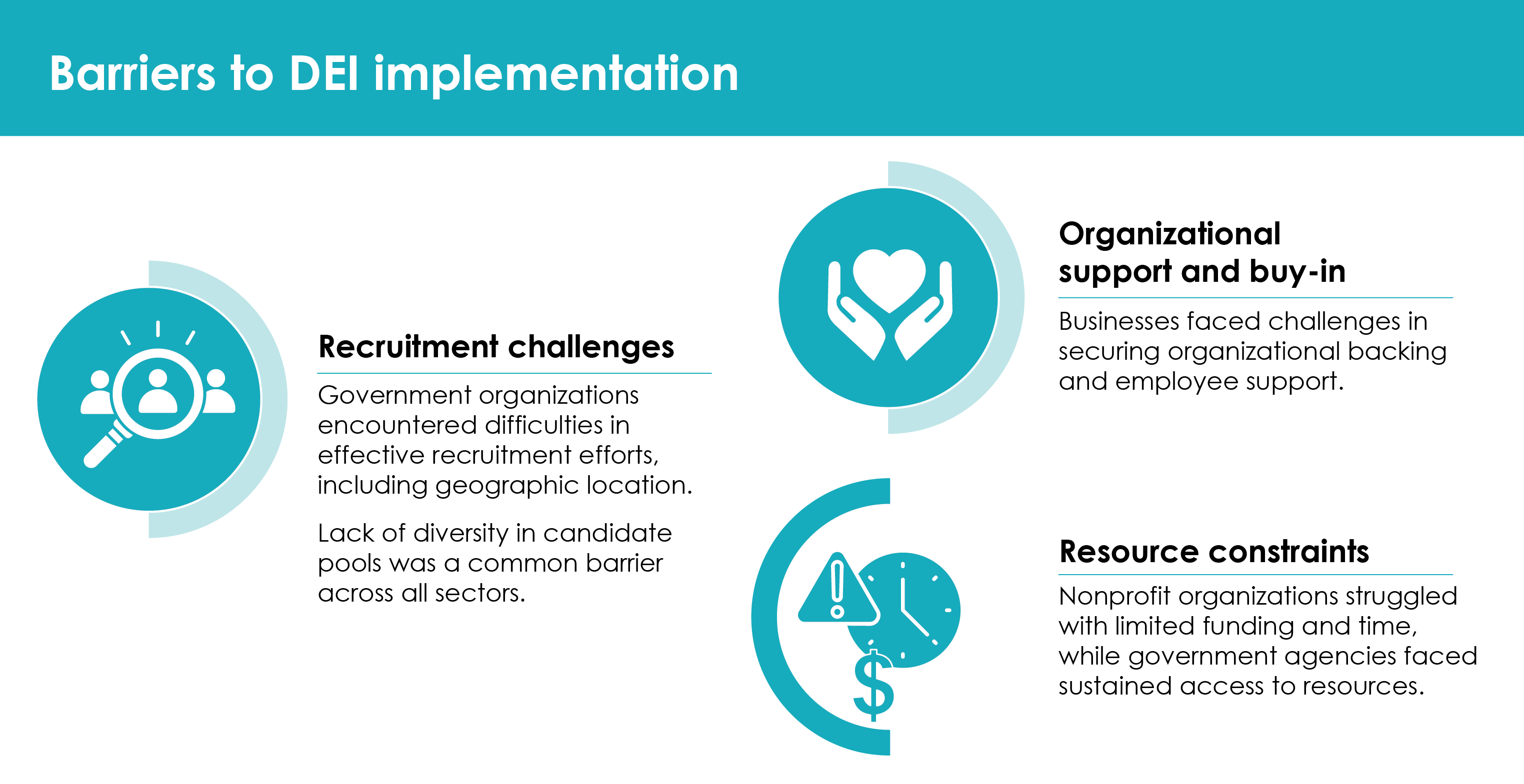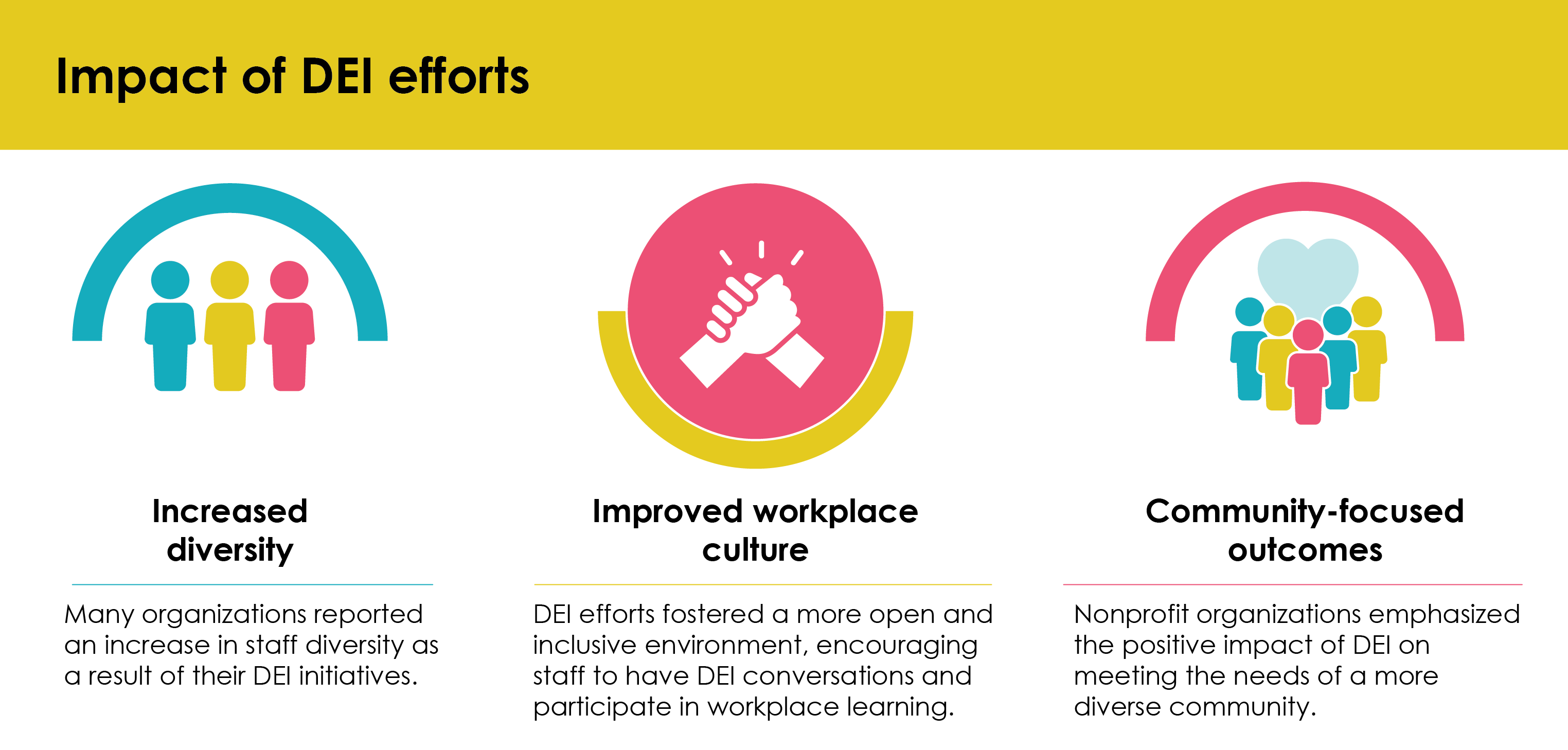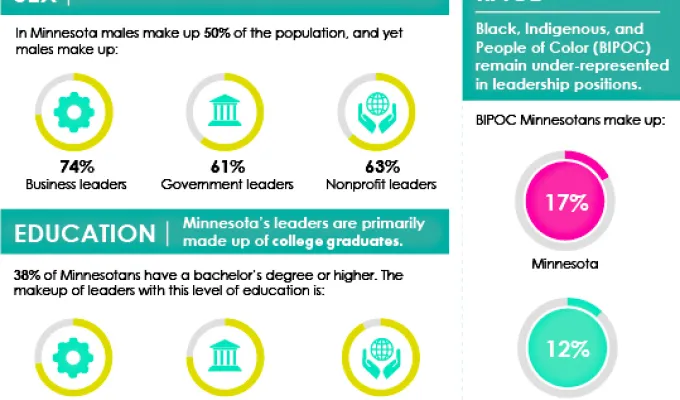The events of 2020, from the COVID-19 pandemic to the protests for racial reckoning, significantly accelerated organizations' focus on diversity, equity, and inclusion (DEI). Since then, Human Resources (HR) departments have seen a surge in both the implementation of DEI programs and the scrutiny they face regarding these efforts.
What does this look like for Minnesota's institutions? How are they incorporating DEI into hiring, retention, and leadership development, and what are the outcomes? Minnesota Compass and Wilder Research interviewed HR professionals in government, business, and nonprofits to better understand the challenges organizations face in implementing DEI initiatives and the effectiveness of their strategies.
The interviews, conducted every two years, are part of the "Who Leads in Minnesota?" project of Minnesota Compass and the Bush Foundation. The project combines census and survey data to paint a complete picture of who leads our institutions and explore how we can inspire equitable and inclusive leadership across age, race, and more. The findings in this article reflect data collected in 2023. Results from the previous round of interviews can be found here.
Barriers to DEI implementation
Our conversations with HR professionals suggested that the speed at which some DEI efforts were implemented brought their own set of issues. Here are four challenges that rose to the top in conversations with the interviewees.
Resource constraints
Both nonprofit and government HR interviewees mentioned resource limitations as a barrier to successfully sustaining DEI initiatives.
“There are a lot of good things in place at my company. But there are a number of foundational HR things to put in place. There’s a lot more I want to do, but it’s about having enough staff and resources to do it. We run lean. The desire is there once we get deeper into the DEI space,” a nonprofit interviewee said.
The concept of “running lean” and the very real experience of funding challenges were echoed by others.
“Some of the most significant barriers are time and the capacity to either design or lead [DEI] efforts,” an interviewee explained. “As a nonprofit, we are a very lean-staffed organization, and we want to be good stewards of the financial resources that are granted to us or donated to us.”
One interviewee mentioned that good, intentional training that is tailored to the organization’s needs comes at a cost. “We want to pay for the quality and directly support the BIPOC (Black, Indigenous and People of Color) consultants who provided that training and work. It’s good value, but the funding that we have is stretched thin.”
Recruitment challenges
One nonprofit interviewee found lack of funding impacts their DEI hiring practices. “I can't get the funds unless I have the diverse candidates and I can't get diverse candidates unless I have the funds, so it's a double-edged sword.”
Interviewees from government organizations mentioned encountering difficulties in effective recruitment efforts, including geographic location.
One government interviewee reflected on the lack of diversity and opportunity in a greater Minnesota community that is elderly and predominantly White. “It makes it difficult to recruit people when they don’t see a very diverse community. If they do move here, they don’t stay long.”
In addition, “Most people have two working parents in the home. We may be able to hire, but the community is not large enough for the other spouse to find employment too. That is our biggest obstacle right now.”
Organizational support and buy-in
Business HR interviewees listed both securing organizational backing and winning employee support for DEI efforts as major barriers.
“There is a concern that in doing positive outreach to one group, you are excluding another group. I think it is way more a perception than a reality. When we put our Young Professional group together, there was a perception from our older employees that they are not welcome at these activities. Perception, but not reality.”
A government interviewee stated that their organization's DEI committee has faced significant challenges due to frequent leadership changes. “This instability has led to a decline in committee members and a lack of focus on specific DEI initiatives. The ever-changing landscape of social and political issues has also contributed to the committee's struggles, as they find it difficult to prioritize specific goals amidst the constant flux of events.”
Some of the nonprofit HR professionals interviewed discussed the need for a more supportive infrastructure for a workforce that is already diverse.
“There’s a lot of trauma that has happened in people's life. It is hard for people to feel like they can speak freely in the same space…the hardest part is establishing the trust that we are guiding this in the right direction,” one interviewee said.
“One of the challenges for us is specifically for people who supervise other staff who are from different cultural backgrounds. I’ve really had to work with support staff from different cultures around our performance evaluations,” a nonprofit interviewee shared. “With several of the cultures that work for us, it is not part of their culture to promote themselves. That’s something I’m very aware of whenever I have a new supervisor brought on. We have a conversation about it.”
“It is hard to get hiring managers and the selection committee to be more open-minded. The barrier is the balance between educational requirements versus work experience. So, how do we make sure that we try to break the mold of who is the best candidate?” an interviewee shared.

Effective DEI strategies
Alongside talking about barriers to DEI efforts, interviewees shared the DEI strategies that worked best for their organizations.
Top DEI strategies included:
Staff conversations
Across all sectors, interviewees emphasized the importance of open and inclusive discussions about DEI. One of the most successful strategies among interviewees was maintaining open and inclusive discussions about DEI, and DEI-related training to staff in general.
For one government organization, an equity toolkit helped spark dialogue. “It's provided deeper conversation and opportunity to really understand what the equity impact is of a decision. I can't say if a decision would be made differently prior to that. I think it's resulted in greater dialogue, understanding, and education of our decision-makers.”
A nonprofit interviewee lifted up ongoing talking circles as a successful strategy. “To me it feels like the cumulative efforts of [the talking circles] and the gradual agreement on concrete definitions and actions is the most powerful. We’ve been doing monthly talking circles, and each time we grow in awareness and understanding and get closer to understanding what we need to do as an organization.”
Creating spaces to talk about issues when they occur was well received by staff of one nonprofit. “Also, the process of doing DEI work and not from the top down. It has been very rewarding and therapeutic for some. I have some staff who came directly to me and told me how appreciative and thankful they are to be able to be part of it.”
Another nonprofit HR executive shared, “In most cases what we try to do in our own facilitation is stay away from ‘This is what you should learn from this.’ It's giving folks the material and having folks talk to each other about things that surprised them, what they learned, and how they relate. The intent is having these conversations so folks can hear from each other and learn from each other rather than learn from a talking head at the front of the room. And what we're seeing from that is that people are starting to form these coalitions like the LGBTQ+ task force to do specific DEI work and to advance that work rather than it being directed. For us, that's the goal – that it comes from the culture of the organization so that, when it's done and implemented, it becomes the culture of the organization. It isn't just changing this policy and suddenly everyone behaves differently. I think those conversations have been the most impactful.”
Training and education
Providing DEI-related training to staff was another impactful strategy.
A government HR manager described one training that was well received. “Overall, we had a large employee population that was not familiar with implicit bias. After that training, we were able to introduce some other training to the staff without a lot of resistance from them. There was less push back. Initially, before the training, staff asked why we did this and what for. Even the leaders were more open and seem excited about it after that. We also noticed a higher participation response rate in our engagement survey.”
“The ripple effect of the training is that we have a new language…to pull from in talking about our work practices and policies. It is integrated. I can use it with the board and all the staff. It gave us a new lens,” a nonprofit executive shared.
Hiring and recruitment practices
Organizations that revised hiring and recruitment processes to promote diversity saw positive results.
“We focused on training our interview panel to be more inclusive, to ask the right questions, and to identify implicit bias,” a nonprofit HR manager said. “We’ve implemented things like interview preparation either by phone or email. We prepare our candidates. We try to make that process really inclusive. We send them questions ahead of time to make it a more successful process. I think all of these things have gone to really increasing the diversity of our staff.”
One business HR professional shared that a DEI career-training program was one of the reasons they joined the company. “I felt the program was such an innovative idea. [It] is a statement of our organization’s commitment in a real tangible way. That program is the biggest, most impactful thing that we have done. I’m excited because I’m expanding it to get our competitor firms to join in, where we can come together as an industry. We are trying to be an industry leader in reducing barriers and opening doors to get into our industry.”
Two government interviewees described two opposite hiring tactics that were working in their organizations. One spoke about recruiting outside of their community to create a more diverse hiring pool. The other said they have created more inclusive job postings and hiring processes to attract a growing diverse population in their community.
Board support
Several of those interviewed mentioned that explicit support from organizational leadership was crucial for successful DEI implementation.
“The key leaders and board just did a racial equity statement last year that was really impactful. I think staff really appreciated that we made a statement,” a nonprofit interviewee shared.
A nonprofit executive talked about making substantive changes to who is invited to be on the board in order to create a more inclusive environment for the entire organization. “It is changing what is seen as ‘valuable experience’ when recruiting board members. I’m shifting the board to understand that what is equally important is having an understanding of the people we serve and the experience of being a new American. It doesn’t mean they are the new American. Maybe they are second generation and have seen, or have a deep understanding of that experience. I feel very strongly about board service and [ensuring] that the opportunity is available to any and everyone, and that it’s not closed and only available to a certain kind of job, certain kinds of friends and money.”
Community engagement
Some interviewees identified increased opportunities for community feedback and involvement as beneficial.
A government interviewee described gaining community input for a playground as a way of soliciting feedback from a broader range of individuals and experiences. “We've been going to the community to ask what they want, instead of city staff deciding. We've done surveys with people sitting in the park and asked questions. We've done phone calls. We went to the city's festival and had boards with pictures of different kinds of playground equipment. We've gone to the school staff. I would say that has been one of the most impactful things we've done.”
Another government interviewee stated that focusing on better, more welcoming customer service has been a game-changer. “People are more open to ideas and understand what the city leadership expect in regards to serving the community. It is impactful and provides better customer relations in all our departments.”
An interviewee shared that their nonprofit recognized the importance of reflecting the community they serve. “Our staff and our clients are more diverse than it has ever been in the history of our organization. Because the community sees more diverse staff, we get more diverse clients. As our diversity dynamic changes, we are seeing more people that have been forced on the margin to come in for services.”
Another nonprofit interviewee also talked about changing to meet the needs of a more diverse community. “When we were founded 50 years ago we were predominantly a white, working-class community. Over the years, it has diversified. In the past 2-4 years, our efforts to ensure that we meet the needs of a more diverse community have become much more intentional. I think it shows in the increased amount of people who feel more welcome to come here, even if they don’t speak English well or at all.”
Yet another nonprofit executive explained the importance of community engagement to make meaningful changes to programming: “People come in with different perspectives, experiences, and views, and it is healthy. It has provided some good challenges for us as far as increasing the diversity in our artistic programming and who is on stage; that directly impacts our audience. The feedback we’ve received from the audience has been good responses; ‘I feel like I’m represented on stage. There is someone who looks like me on stage.’ That goes down to youth: ‘My son was intrigued to see that you had a black trombone player.’ That is newer impact and newer success that we are seeing.”

Recommendations you can implement
While challenges exist, organizations in Minnesota's business, government, and nonprofit sectors are making progress in implementing DEI initiatives. By addressing the identified barriers and adopting effective strategies, organizations can create more inclusive and equitable workplaces that benefit both employees and the communities they serve. Here are some recommendations to consider when developing or evaluating your organization’s DEI efforts:
- Prioritize diversity in recruitment: Implement strategies to attract a more diverse pool of candidates.
- Foster organizational support: Cultivate a culture that values DEI and encourages employee participation.
- Allocate resources: Ensure adequate funding and time are dedicated to DEI initiatives.
- Invest in training: Provide comprehensive DEI training to staff to address knowledge gaps and promote understanding.
- Engage with the community: Seek feedback from community members to inform DEI efforts and ensure they meet community needs.
- Measure and track progress: Regularly assess the effectiveness of DEI initiatives in order to identify areas for improvement.
STAY TUNED FOR MORE DATA
Even as this is published, Minnesota Compass and Wilder Research are working on the next round of data collection about Minnesota’s leaders through surveys and interviews. It is an ongoing process that we hope helps Minnesota’s institutions better understand the current landscape of leadership in Minnesota and identify ways to better support the field now and in years to come.


